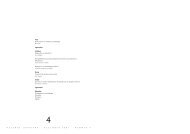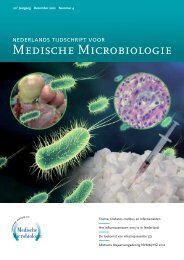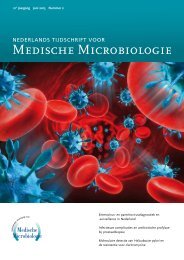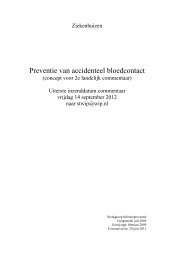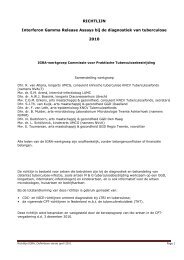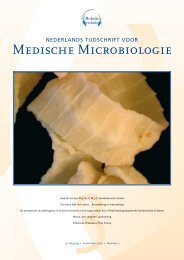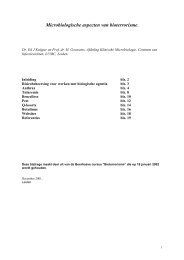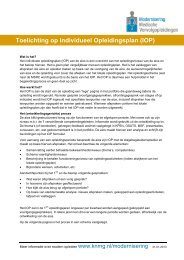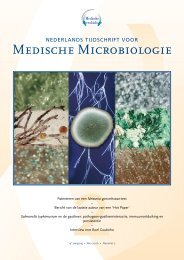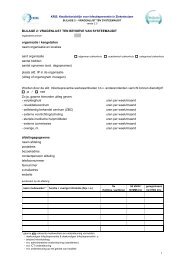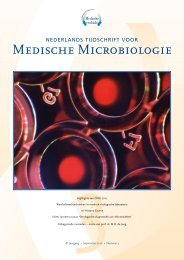S1 De voorjaarsbijeenkomst van de Nederlandse ... - NVMM
S1 De voorjaarsbijeenkomst van de Nederlandse ... - NVMM
S1 De voorjaarsbijeenkomst van de Nederlandse ... - NVMM
Create successful ePaper yourself
Turn your PDF publications into a flip-book with our unique Google optimized e-Paper software.
infections. In particular infections caused by methicillinresistant<br />
S. aureus (MRSA) pose a major problem in health<br />
care settings. In the Netherlands, the restricted use of<br />
antibiotics and a ‘search and <strong>de</strong>stroy’ policy have kept<br />
inci<strong>de</strong>nce at a low level. However, in recent years there<br />
seems to be a slow increase in inci<strong>de</strong>nce and the finding<br />
that there is an animal reservoir has increased the interest<br />
further. As a result, there is consi<strong>de</strong>rable interest in<br />
molecular typing to study the epi<strong>de</strong>miology of MRSA.<br />
S. aureus seems have a relatively stable core genome<br />
resulting in a predominantly clonal genomic background.<br />
Increased virulence and antibiotic resistance is acquired<br />
through lateral transfer of DNA. The clonal nature of<br />
S. aureus background enables the i<strong>de</strong>ntification of certain<br />
lineages through molecular typing. A plethora of typing<br />
techniques have been used to characterise S. aureus, but<br />
in recent years PFGE, MLST and spa-sequence typing<br />
have become the most wi<strong>de</strong>ly used techniques. The, until<br />
recently, most frequently used technique, PFGE, is a band<br />
based technique which is difficult to standardise and<br />
unsuitable for (inter)national molecular typing databases.<br />
The sequence based MLST is a robust technique yielding<br />
unambiguous results that is extremely well suited for<br />
electronic data exchange. However, MLST is both labor<br />
intensive and expensive. Spa-sequence typing is rapidly<br />
becoming the new molecular typing standard for S. aureus.<br />
However, spa-sequence typing uses only a single genomic<br />
locus for typing which may result in insufficient discriminatory<br />
power. For this reason, we <strong>de</strong>veloped a MLVA<br />
and compared typing capabilities with those of PFGE and<br />
spa-sequence typing.<br />
For MLVA, the number of repeats was <strong>de</strong>termined by<br />
amplifying the VNTRs of 8 different VNTR loci, including<br />
spa, in 2 multiplex PCRs. The fluorescently labeled PCR<br />
fragments were size on an automated DNA sequencer and<br />
the number of repeats of each locus was combined to create<br />
an 8-number numerical MLVA profile which was used for<br />
clustering. Approximately 1680 S. aureus strains (predominantly<br />
MRSA) isolated from humans were inclu<strong>de</strong>d in the<br />
study. Although MLVA yiel<strong>de</strong>d many different genotypes<br />
most types could be assigned to one of 11 large complexes<br />
which were ma<strong>de</strong> up of single-locus MLVA variants. There<br />
was 52% congruence between MLVA and spa-sequence<br />
typing and 33% congruence between MLVA and PFGE.<br />
Congruence between spa-sequence typing and PFGE<br />
amounted 40%. Sensitive S. aureus strains (MSSA) were<br />
present among all MLVA clusters and no MSSA-specific<br />
MLVA types were found. MRSA strains belonging to the<br />
PFGE non-typeable class, often referred to as pig strains all<br />
belonged to single MLVA complex, confirming the clonal<br />
nature of this type of strains.<br />
MLVA appears to be a method that is suitable for molecular<br />
typing of S. aureus. Its simplicity, robustness, relatively<br />
low costs and unambiguous data make it an alternative<br />
Ned Tijdschr Med Microbiol 2008;16:Supplement<br />
S22<br />
for MLST. The method is superior to PFGE and its data<br />
are easier to use in clustering than those obtained by<br />
spa-sequence typing.<br />
O056<br />
The epi<strong>de</strong>miology of Clostridium difficile PCR-ribotype 027<br />
in The Netherlands since 2005<br />
D.W. Notermans 1 , T.I.I. <strong>van</strong> <strong>de</strong>r Kooi1 , A. Goorhuis2 ,<br />
S.B. <strong>De</strong>bast3 , B.H.B. <strong>van</strong> Benthem1 , E.J. Kuijper2 1<br />
Centre for Infectious Disease Control, National Institute<br />
for Public Health and the Environment (RIVM), Bilthoven,<br />
2 3 Lei<strong>de</strong>n University Medical Centre, Lei<strong>de</strong>n, Mean<strong>de</strong>r Medical<br />
Centre, Amersfoort<br />
Introduction: In 2005, outbreaks of Clostridium difficile<br />
associated diarrhoea (CDAD) with the virulent PCR<br />
ribotype 027/toxinotype III were first reported in the<br />
Netherlands. C. difficile PCR ribotype 027 was already<br />
causing consi<strong>de</strong>rable problems in hospitals in the United<br />
States, Canada and England over the preceding years.<br />
Several investigations have shown an increase in morbidity<br />
and mortality and an increased relapsing rate for this type.<br />
Studies on risk factors at individual patient level showed an<br />
association with fluoroquinolones.<br />
Methods: The Centre for Infectious Disease Control at the<br />
National Institute for Public Health and the Environment<br />
(RIVM) set up surveillance for CDAD in collaboration with<br />
the Lei<strong>de</strong>n University Medical Centre (LUMC). Hospitals<br />
can send isolates or toxin positive faeces samples for typing,<br />
if they suspect type 027 based on an increased CDAD<br />
inci<strong>de</strong>nce or a severe clinical picture. From hospitals with<br />
an outbreak with or transmission of type 027, information<br />
is collected, including monthly CDAD inci<strong>de</strong>nce.<br />
Results: Between February 2005 until half August 2007,<br />
1886 samples have been typed, coming from 75 healthcare<br />
institutions and laboratories. In 418 cases (22%), PCR<br />
ribotype 027 was found. PCR ribotypes 001 (18%), 014<br />
(7%) and 078 (8%) were also frequently found. To this<br />
date, in 23 of in total of 97 Dutch hospitals, type 027 has<br />
been <strong>de</strong>tected. In 13 of the hospitals, the introduction<br />
of 027 caused an increased inci<strong>de</strong>nce of CDAD, two of<br />
which occurred since <strong>De</strong>cember, 2006. Ribotype 027<br />
has also been <strong>de</strong>tected in ten nursing homes. In eight of<br />
11 hospitals where ribotype 027 was <strong>de</strong>tected in 2005 or<br />
2006 and outbreak occurred, no ribotype 027 has been<br />
<strong>de</strong>tected since April, 2007. Two hospitals that had the<br />
epi<strong>de</strong>mic well un<strong>de</strong>r control for a long time were faced<br />
with a new increase in inci<strong>de</strong>nce. In most of the hospitals<br />
where outbreaks occurred in 2005, the inci<strong>de</strong>nce <strong>de</strong>creased<br />
substantially in 2006.<br />
Conclusion: The spread of PCR ribotype 027 in the<br />
Netherlands is still continuing. Outbreaks in new institutions<br />
are limited compared to previous hospital epi<strong>de</strong>mics in



